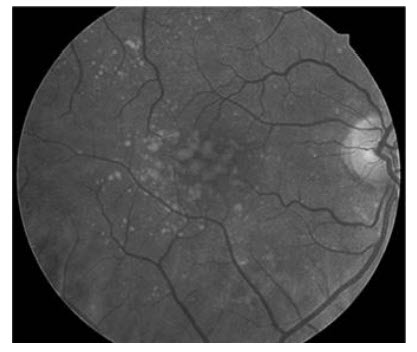Question 2#
A 69-year-old woman complains of gradually worsening vision over the last 2 years. She can no longer read the newspaper on her porch in the early evening, and sometimes has difficulty seeing faces and distinguishing colors. She has hypertension and smokes cigarettes, but does not have diabetes. Her only regular medication is lisinopril. Funduscopic examination is shown below.

What is the next best step in the evaluation of this patient?
A. Determination of fasting blood sugar and hemoglobin A1CB. Referral to an optometrist for tonometry
C. Recommendation that she stop smoking cigarettes, take antioxidants, and see an ophthalmologist
D. Referral to an ophthalmologist for cataract extraction
E. MRI scan of the brain with particular attention to the pituitary
Correct Answer is C
Comment:
The ophthalmologic examination shows drusen. These pale yellowish retinal lesions can often be seen with a handheld ophthalmoscope. Drusen are caused by deposition of acellular debris between the retinal epithelium and Bruch membrane. These lesions are the hallmark of age-related macular degeneration, which is the leading cause of blindness in older adults in the United States. Evidence suggests that antioxidants (such as beta-carotene, vitamin C, or vitamin E) and zinc can prevent the progression of age-related macular degeneration. About 15% of patients with macular degeneration have a “wet form” which leads to more severe visual loss and which is treated by photocoagulation and intraocular injections of anti-vascular endothelial growth factor antibodies (anti-VEGF). Ophthalmologic evidence of open angle glaucoma consists of an increased cup-to-disc ratio. Glaucoma is diagnosed by the characteristic optic nerve appearance and visual field loss. Many (but not all) patients with open angle glaucoma have an elevated intraocular pressure which can be detected by tonometry. Diabetic retinopathy is characterized by microaneurysms and neovascularization and is treated by photocoagulation and optimizing blood sugar control. Cataracts are a common cause of vision loss in the elderly, but do not cause retinal abnormalities. Pituitary tumors can cause visual field defects and/or papilledema, but do not cause drusen.